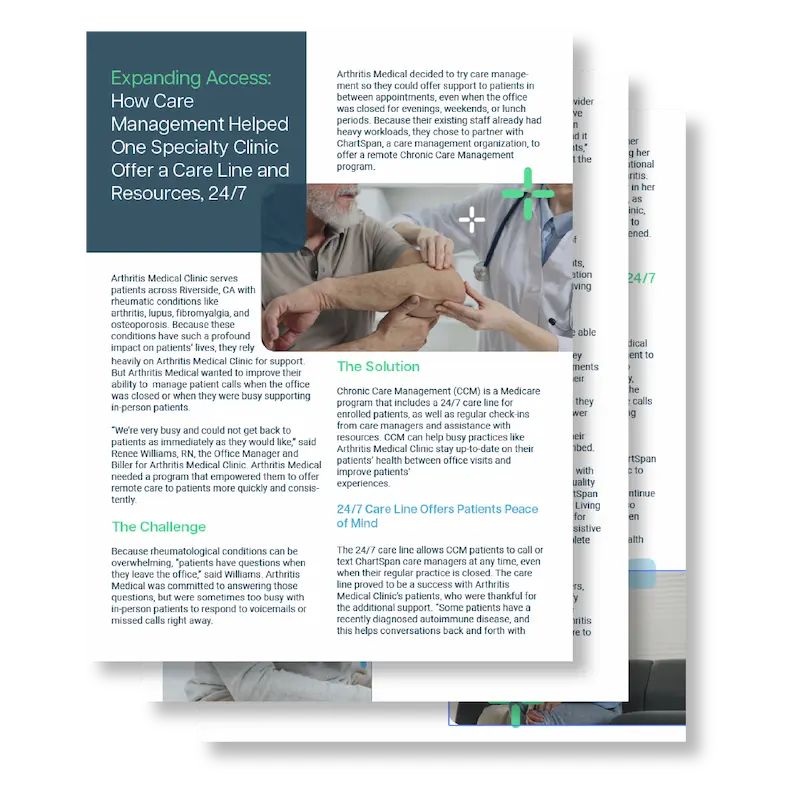
Talk with a ChartSpan Representative Today!
Our team is ready to help you improve patient care and outcomes.
Blog
Value-Based Care Programs – Which Ones Deliver Results?
The term “Value-Based Care” describes healthcare’s attempt to shift away from an exclusively Fee-for-Service (FFS) model, where providers are paid based on the volume of services they offer. Value-based care (VBC) ties reimbursements to a set of patient outcome data points. If you perform well according to the benchmarks of your VBC program, you are rewarded, usually in the form of financial bonuses or increased reimbursements. If you don’t perform well, you could miss out on bonus payments or even have your reimbursements reduced.
Grading practices based on performance is where the complexity begins. There are numerous payer models, programs, services, and CPT codes that fall under the value-based care umbrella. So how do you determine which program is right for your practice?
We’ll break down different types of value-based care programs and services, including a few programs that combine VBC and FFS payments, to help you determine which programs deliver the best patient outcomes and fairest reimbursements for your practice.
Which value-based care program is best to start with?
Practices often ask ChartSpan about the best way to begin moving towards VBC revenue. We recommend evaluating each program using the following questions:
- How much investment will this require of my organization?
- How will this program impact my patients?
- Which program matches the needs of my specific patient population?
- What is the revenue opportunity with this program?
- Is there a downside risk?
- Does this program enhance my ability to perform in the other programs?
We’ll tackle each of these questions for some of the most popular value-based care programs that practices often consider.
Transitional Care Management (TCM)
TCM is a preventative wellness program for patients with moderate or high-complexity medical issues who are transitioning out of an inpatient setting, such as a hospital or skilled nursing facility. The program is available for 30 days after the patient’s release and aims to prevent readmissions. It is a fee-for-service offering that enhances value-based care.
PROS: When performed well, TCM can positively impact MSSP Shared Savings programs through lower readmission rates, and has no downside risk. Most importantly, TCM can improve patients’ quality of life by helping them stay out of the hospital.
CONS: Without a dedicated admission discharge transfer (ADT) feed from hospitals, practice staff must manually identify the need for TCM, which can be difficult and time-consuming. Patients must also show up for an in-person appointment for their provider to be reimbursed. These requirements lead to low revenue.
Remote Patient Monitoring (RPM)
RPM uses technology to monitor and report on health data from patients with acute or chronic conditions. The devices are often enabled at the patient’s home and send collected medical data back to their provider. RPM is a fee-for-service program that can also help with VBC efforts.
PROS: RPM provides per-patient, monthly recurring revenue opportunities through multiple codes. Early data indicates RPM is effective for patients with acute care needs, though it is less clear on the benefits for relatively healthy patients. There is no downside risk, and RPM could improve quality scores.
CONS: This program is logistically complex; it requires the management of hardware, software and devices for patients who may be technologically challenged. High copays for patients will inhibit enrollment, and program churn-out rates could be high as patients absorb their copays. Additionally, you might need to invest in robust third-party software to deploy a program.
Accountable Care Organizations (ACO) and the MSSP Program
An ACO is a group of healthcare practitioners who voluntarily agree to share responsibility for the quality and cost of care they provide to patients. One of the most popular ACOs is the Medicare Shared Savings Program (MSSP), administered by CMS. ACOs are value-based care models.
PROS: ACO programs’ revenue upside can be sizable if practices and health systems perform well. Many ACOs provide templates and personnel to guide participant performance throughout the year. They are able to focus on reducing patient cost of care while enhancing quality, and many value-based care programs work well in conjunction with ACO membership.
CONS: ACO participation requires significant upfront investment and potential ongoing fees, depending on the ACO’s structure. Many ACOs perform poorly, never achieving shared savings for their members. ACOs also come with risk, as some practices lose money when their performance is grouped with the performance of other practices.
At-Risk Payer Plans
With at-risk plans, healthcare entities receive capitated payments for attributed beneficiaries. The entity is then financially liable for all costs associated with the care of their attributed patients. If patient costs are lower than the allotted payments, the entities get to keep a portion of the savings. At-risk payer plans are value-based care programs.
PROS: Individualized payer plans offer high potential revenue upsides if you perform well. They are similarly designed to MSSP and ACOs: however you’ll often have more flexibility to impact cost savings and improve the quality of your patient care.
CONS: There is a high potential downside risk. The penalties that are assessed for poor performance can be expensive. To be successful, your Quality Manager must be well-versed in and have mastered all the VBC program’s elements. You will need to invest significant resources into your quality teams. At-risk payer plans are also often incompatible with other fee-for-service programs.
Chronic Care Management (CCM)
CCM is a Medicare program that reimburses providers for non face-to-face care coordination services for patients who have been diagnosed with two or more chronic conditions. It is a preventative program designed to address the needs of patients in-between their office visits.
PROS: 82% of Medicare patients qualify for CCM, and it can help them reduce their risk of unnecessary ER visits and hospitalizations. CCM also ensures patients have 24/7 access to care. The program can be billed every month, leading to a sizable revenue stream opportunity for practices.
Outcomes of the program align with other VBC revenue programs, such as ACOs. The CCM program creates a closer relationship with high-acuity patients, which often translates to more office visits and increased FFS revenue. There is no downside risk.
CONS: While CCM doesn’t require as much upfront investment as ACOs or at-risk plans, it is operationally complex. Patient enrollment can be challenging, and the program can have high churn rates if the patient experience isn’t well-executed. Additionally, CCM is not available to patients with one or fewer chronic conditions, limiting its reach. Practices who launch the program internally may also struggle to provide 24-hour access to care managers and to record and bill for care manager time.
Advanced Primary Care Management (APCM)
Advanced Primary Care Management is one of Medicare’s newest care management programs as of 2025. Like CCM, it provides remote, preventative care in between office visits. However, it requires more in-depth care management capabilities than CCM does, is available to patients regardless of their number of chronic conditions, and bases results on quality measures, rather than time spent per patient. It combines FFS and VBC revenue.
PROS: Medicare patients are eligible for the program regardless of their number of chronic conditions. Like CCM, APCM offers 24/7 access to care and can reduce unnecessary ER visits and hospitalizations. Monthly billing offers an additional revenue stream for practices, and APCM can enhance practices’ performance in other VBC programs, like ACOs. There is no downside risk.
CONS: APCM can be more operationally complex than many other Medicare programs. It requires the ability to stratify patients into levels based on the acuity of their health needs, to collect population health data, to interpret quality measure performance, and to manage transitions from one healthcare setting to another. Encouraging patients to enroll and ensuring they have a great experience can be time-consuming, as can tracking care and managing billing.
Annual Wellness Visits (AWVs)
The AWV generates a personalized prevention plan that is designed to help prevent disease and disability based on the current health and risk factors of a patient. This plan is determined by the patient’s self-reported answers on the Health Risk Assessment questionnaire.
PROS: Virtually every Medicare patient is eligible to complete and be reimbursed for an AWV. All copays and deductibles have been waived. This program presents a decent revenue opportunity for practices if you can achieve good capture rates. It is easy to launch with various software options, and can align with ACO and at-risk plan programs. There’s no downside risk.
CONS: AWVs can only be completed once a year. Patients usually don’t like coming in for well visits, which can hinder capture rates. AWVs may also add work for clinical staff if they don’t have a seamless way to administer the health risk assessments and check patients’ eligibility. While adding tertiary codes can enhance the AWVs’ value to the patient and the practice, they can also make AWVs more time-consuming for providers.
Choosing the Right Program for Your Practice
Value-based care programs range from high-risk, high reward to low-risk, low reward and from operationally straightforward to incredibly complex. In addition, most VBC programs not only affect one another but can be mission-critical to each other's success.
After working with hundreds of medical organizations, we’ve determined that the easiest entry points into value-based care are usually Annual Wellness Visit (AWV) and Chronic Care Management (CCM) programs, followed by the Advanced Primary Care Management (APCM) program. The rationale for this recommendation comes from our initial evaluation questions.
How much investment will this require of my organization(s)? (financially & resources)
CCM and AWV do not require major capital investments to initiate if you have a partner. They can be complex if you try to set them up internally. APCM is even more operationally complex than the previous two programs, though still simpler than an at-risk program or an ACO. Partnering with an outside organization for CCM, AWVs or APCM can make these programs much easier.
How will this program impact my patients?
ChartSpan claims data shows that CCM can reduce the risk of 30-day hospital readmissions by an average of 52% and total patient costs by an average of 21%. Though APCM is a new program, we expect to see similar results to CCM. AWVs offer providers the chance to supplement care management with in-person preventive care and Health Risk Assessments.
Which program matches the needs of my specific patient population?
Any practice with Medicare patients can benefit from AWVs. If most of your
Medicare patients have multiple chronic conditions, CCM can be more beneficial. But if you have a range of Medicare patients, from those with one chronic condition to those with extensive socioeconomic needs, APCM could be a better fit. APCM can also be a better fit if the majority of your patients are relatively healthy and not high-acuity.
What is the revenue opportunity with this program?
All CPT codes have a financially meaningful reimbursement attached. CCM and APCM both provide monthly FFS revenue, as well as helping you improve your quality measures. AWVs provide annual FFS reimbursement and can also help with quality measures.
Is there a downside risk?
There are no performance penalties for AWVs or CCM. APCM will use quality measures to determine if the program is successful, but as of its launch, there is no downside risk.
Does this program enhance my ability to perform in the other programs?
APCM, CCM and AWVs possess the foundational elements to help you perform better as part of an ACO or other alternative payment model. The assessment portion of the AWV allows patients to self-report information that is crucial in developing an ongoing preventative plan. The CCM and APCM programs are designed to coordinate care from that plan and to ensure care gaps are addressed and quality measure benchmarks are achieved.
Choosing Your Preventive Care Future
Whether you’ve tried to do AWVs or CCM in the past, are thinking of transitioning to APCM, or haven’t tried value-based care yet, these preventative care programs can help you transition into the VBC revenue stream.
Many practices benefit from starting with programs that provide both fee-for-service revenue and support with value-based care. Starting with one program and developing confidence with it can be helpful, as can partnering with experienced value-based care vendors.
If you’d like to learn more about which value-based care programs balance operational complexity with revenue opportunities, check out our concise guide to choosing a value-based care program.
You may also like: The Difference Between PCM, CCM, and APCM: What Providers Need to Know
Subscribe for More Insights
Get valuable resources delivered straight to your inbox.
"*" indicates required fields





